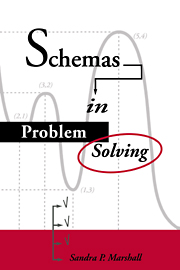11 - Assessment in SPS and PSE
Published online by Cambridge University Press: 22 October 2009
Summary
The two computer-implemented systems described earlier, SPS and PSE, each offer unique assessment opportunities. SPS provides a way to track schema development for each individual over a common set of exercises, allowing comparisons among individuals as well as determination of which knowledge components are weak or strong. PSE adds diagnostic information about the ways in which an individual structures his or her own problem solving, giving explicit details about how the individual constructs and implements a plan. This chapter asks two questions of assessments derived from the PSE and SPS systems: First, how do they compare with traditional assessments, and second, what do they offer beyond traditional ones? To examine the first question, we compare the results of a problem-solving test with those of an aggregation of SPS questions. To answer the second, we look to performances of individual students as well as to single item analyses. Before doing either, however, I shall review the structure of the SPS exercises and the assessment variables associated with them.
Schema-based measures and SPS exercises
Identification score
Students indicate their acquisition of identification knowledge on two exercises. Both exercises require the student to apply identification knowledge in order to judge whether the conditions necessary for a particular situation have been met. For one exercise, the student's response is the selection of the name of the situation from a menu of all five names. For the second exercise, the student's response is the selection of the appropriate icon from a menu of icons.
- Type
- Chapter
- Information
- Schemas in Problem Solving , pp. 290 - 314Publisher: Cambridge University PressPrint publication year: 1995



